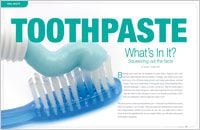

The soft, slightly grainy paste that you squeeze on your brush is the latest in a long line of tooth-cleaning substances whose first recorded use was around the time of the ancient Egyptians. Those early mixtures had ingredients like crushed bones, pumice and ashes — but you won’t find that any more. Modern toothpastes have evolved into an effective means of cleaning teeth and preventing decay. Today, most have a similar set of active ingredients, including:
Besides their active ingredients, most toothpastes also contain preservatives, binders, and flavorings — without which they would tend to dry out, separate… or taste awful. In addition, some specialty toothpastes have additional ingredients for therapeutic purposes.
What’s the best way to choose a toothpaste? The main thing you should look for is the American Dental Association (ADA) Seal of Acceptance on the label. It means that the toothpaste contains fluoride — and that the manufacturer’s other claims have been independently tested and verified.
But once you’ve chosen your favorite, keep this bit of dental wisdom in mind: It’s not the brush (or the paste) that keeps your mouth healthy — it’s the hand that holds it. Don’t forget that regular brushing is one of the best ways to prevent tooth decay and maintain good oral hygiene.

Toothpaste It’s something we put in our mouths every day. Yet for those who actually take the time to read that list of ingredients, it can be hard to figure out what it all means. Dear Doctor magazine breaks it all down and reveals a great way to be sure the claims written on the label can be trusted… Read Article